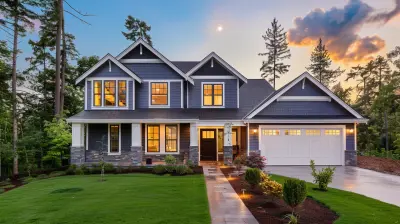The Effect of Demographics on Housing Demand
2 July 2025
Ah, demographics—the word that sounds more like a painful medical procedure than the secret sauce of real estate. But don’t be fooled by its snooze-worthy name. Demographics are basically the puppet masters of housing demand. They’re the hidden force pulling all the strings in the always-fascinating, sometimes-chaotic world of real estate.
So buckle up, because we’re diving into how the people (yes, you) shape the housing market in ways that might just make your next dinner party convo sound like a TED Talk.
What the Heck Are Demographics Anyway?
Let’s start at square one. Demographics are the statistical data of a population—things like age, gender, income, marital status, education level, family size, and that juicy stuff marketers love. Basically, it’s a breakdown of who lives where, how they live, and what they want in life. Sound intrusive? Well, it kind of is. But it’s also the lifeblood of housing demand.Why? Because people need homes. Duh. But what kind of homes, where, how many, and how quickly… now that’s where the demographic magic happens.
Age Ain’t Just a Number — It’s a Housing Blueprint
Let’s start with age groups. Every generation brings a tidal wave of quirky preferences, stubborn demands, and housing “must-haves.” Here’s how they shake up the market:🍼 Gen Z: The TikTok Tenants
These snappy dressers are slowly crawling into adulthood, clutching their oat milk lattes and avocado toasts. They’re not exactly buying homes (yet), but oh boy, they’re renting. Especially in hip, urban areas with Wi-Fi faster than light and a five-minute walk to matcha shops.Gen Z’s impact? They’re punching up rental demand, driving up prices in trendy neighborhoods, and forcing landlords to install USB outlets like it’s a life-or-death scenario.
🏡 Millennials: The Late-to-the-Party Buyers
Ah, the Millennials. The generation that got handed avocado toast instead of a housing market. Thanks to student loans and economic rollercoasters, they joined the housing ownership game a bit later than expected. But now? They’re buying. More specifically, they’re buying in suburbs, hunting for space, good schools, and a backyard big enough for a dog and a trampoline.Millennials have become the market movers—demanding affordable homes with modern finishes and pushing developers to rethink what "starter home" really means.
🧑🦳 Baby Boomers: The Downsizing Dynamos
Boomers are the folks who once needed four bedrooms, two garages, and a mower big enough to look like farm equipment. But the kids are gone, and frankly, so is their interest in upkeep. Now? They want smaller homes, single-story layouts (knees aren't what they used to be), or low-maintenance condos in 55+ communities.As Boomers downsize, they’re creating a ripple: freeing up inventory for younger buyers and spiking demand for senior-friendly housing.
Income Levels: More Dollars, More Square Footage
Let’s be honest—money talks. Loudly. Income levels determine what kind of homes people can afford, and where they’ll plant their flag (or their doormat).🏙️ High-Income Earners: The Custom Kitchen Crusaders
These folks aren’t just looking for homes. They’re looking for wine fridges, granite countertops, and walk-in closets big enough to live in. Their demand drives luxury housing markets in high-end neighborhoods, especially in metro areas where “starter home” means a cool half a million.🏘️ Middle-Income Buyers: The Vanilla Ice Cream Crowd
Middle-income households are the backbone of housing demand. They want reasonable homes in good school districts with enough charm to avoid looking like a clone of every other house on the block. Their preferences keep suburbia alive and thriving.🧾 Low-Income Households: The Overlooked Heroes
Let’s call it what it is—affordable housing is a straight-up crisis. Lower-income families are stuck in long waitlists, battling rising rents, and craving homes that don’t cost an organ. Their needs shine a huge spotlight on the urgency for government assistance, zoning reform, and the often-delayed construction of affordable units.
Household Size: Because Kids Need Somewhere to Scream
The number of people in a household changes, well, everything. A single person doesn’t need four bedrooms. A family of five? They’re not squeezing into a studio apartment without flipping every night into a game of human Tetris.👨👩👧👦 Big Families = Big Demand
More people under one roof means a need for more space. More bedrooms, bigger kitchens, and maybe even multiple bathrooms (because no one wants to argue over who goes first on Monday at 7:45 a.m.).👩❤️👨 Child-Free Couples and Singles = Flexibility Over Footprint
These households want location, style, and maybe a home office. But square footage? Meh. They’re more interested in lifestyle-based housing—think condos with gyms, rooftop patios, or downtown lofts with giant windows and no yard (because who really enjoys mowing the lawn?).Education and Lifestyle: The Fancy Factor
People are getting more educated, and with great degrees comes great expectations. Homebuyers today are more informed (thanks, Google), more selective, and they want lifestyle-friendly homes that match their vibe.🎓 The College Crowd
College towns don’t just have good pizza and sketchy landlords. They also have high rental demand, especially for multi-unit investments. Want to own property where vacancies are rare? Set your sights on cities with universities.🧘 The Lifestyle-Driven Buyer
Today’s buyer might want a yoga room, hiking trails nearby, or a dog park within walking distance. Blame Instagram or Gwyneth Paltrow, but “vibe” matters more than ever.Immigration and Cultural Shifts: The Global Game-Changer
Here’s a not-so-secret secret: immigration fuels housing demand. Immigrants often settle in urban centers, raising the need for diverse housing options—including rental units, starter homes, and multigenerational housing.Plus, different cultures have different housing preferences. Multigenerational households, for instance, are more common in some communities. That impacts demand for larger homes with flexible layouts. hello, in-law suites!
Urban vs. Suburban Showdown
Demographics also decide where people want to live. It’s the perpetual tug-of-war between city buzz and suburban sprawl—and it's dictated by your stage in life.🏙️ City Life: Singles, Students, and Night Owls
Young professionals, students, and Instagram influencers love the city. Why? Because it’s walkable, exciting, and full of overpriced brunch spots. Their presence keeps urban rental markets competitive and forces developers to go vertical—hello, high-rises.🏡 Suburbia: Families and the "We Want a Yard" Crowd
As soon as diapers or school districts enter the chat, city life loses its sparkle. Suburbs offer more space, better schools, and fewer incidents of sidewalk saxophone concerts at 2 a.m. (shocking, I know). This migration fuels suburban construction and reshapes commuter patterns.Remote Work: The Plot Twist No One Saw Coming
Let’s pour one out for the 9-to-5 office job. Thanks to the pandemic, remote work is a thing—and it’s here to stay. Workers realized something revolutionary: “Wait… I don’t actually need to live near the office?”Suddenly, housing demand boomed in areas once considered “low-key”—think rural towns, mountain getaways, and suburbs within an hour of nowhere. People are trading sardine-sized apartments for spacious homes with Zoom-worthy backdrops.
Bye-bye, commute. Hello, home office.
Birth Rates and Marriage: Love, Babies, and Real Estate
Who knew your relationship status could sway the housing market?Fewer people are getting married young, and birth rates are doing the limbo—how low can you go? That means fewer traditional “nuclear families,” more singles living solo, and a rise in demand for smaller homes, condos, and apartments.
But! When people do couple up and have kids, cue the mad dash for family homes in safe neighborhoods. It's a housing mood swing, and it's all about timing.
So What Does All This Mean for the Housing Market?
In a nutshell: demographics drive everything. Developers use it to decide what to build, where to build, and what color granite goes in the lobby. Realtors use it to target their listings. Investors use it to chase the next booming zip code.And if you’re a homebuyer or renter? You’re part of this chaotic dance whether you like it or not.
Your age, income, lifestyle, and latte preferences impact what kind of homes get built, where prices go, and how fast properties fly off the market.
It’s like you’re the star of a show you didn’t even know you were in. Lights, camera, mortgage.
Final Thoughts: People Power the Property Parade
Look, the housing market isn’t some mysterious beast only economists can understand. It’s a reflection of us—our goals, our budgets, our weird obsessions with open-concept kitchens.So, the next time someone brings up real estate at brunch and your eyes start to glaze over, you can hit them with: “Well, it all depends on the demographics.” Trust me, you’ll sound brilliant.
More importantly, whether you’re buying, renting, investing, or just Zillow-ing for fun (we all do it), keeping an eye on demographic trends can help you ride the next housing wave like a pro surfer in a sea of spreadsheets.
Now go forth and drop demographic truth bombs like it’s your job.
all images in this post were generated using AI tools
Category:
Housing MarketAuthor:

Kingston Estes
Discussion
rate this article
1 comments
Maisie Stone
Demographics significantly shape housing demand trends and market dynamics.
July 14, 2025 at 4:27 AM

Kingston Estes
Thank you for your insight! Indeed, demographics play a crucial role in influencing housing demand and market trends.


